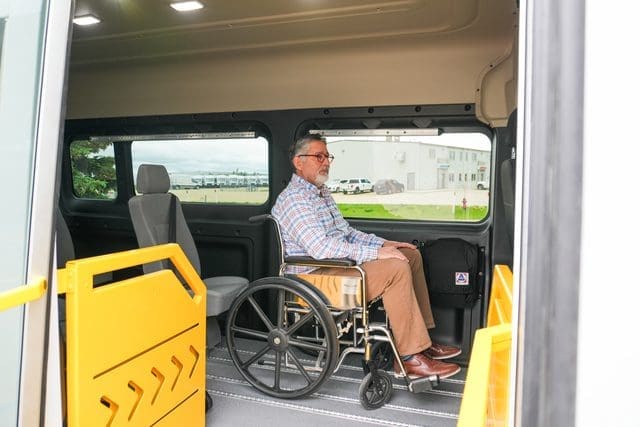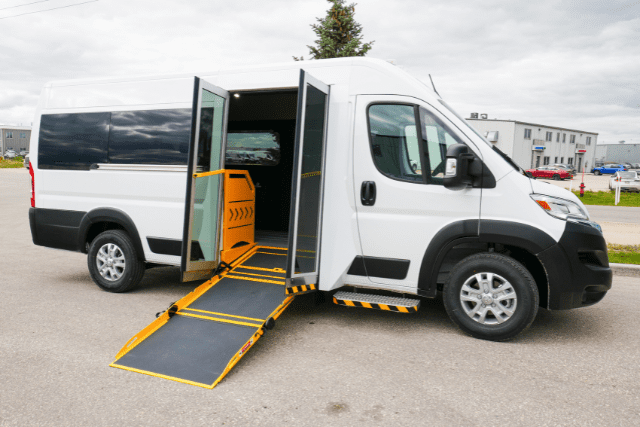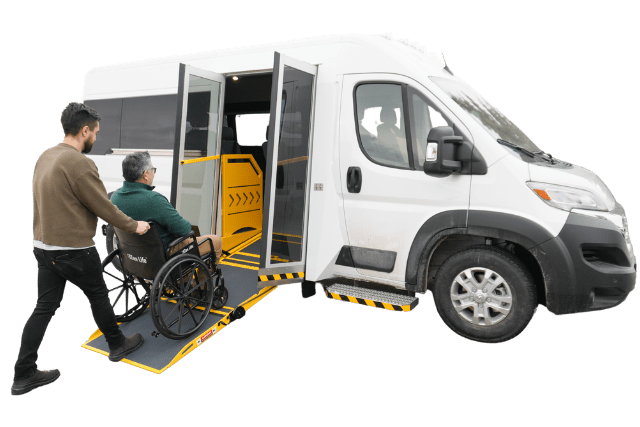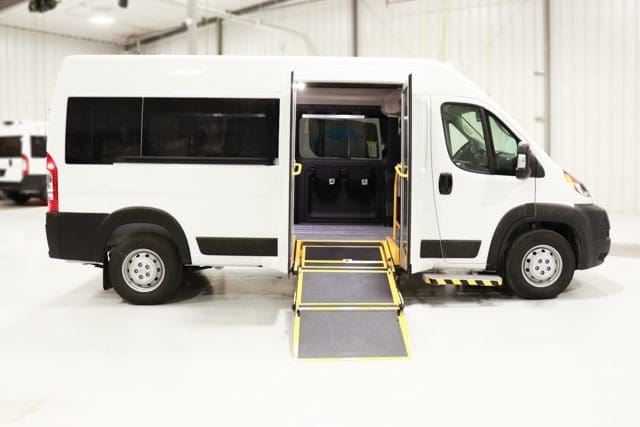If your organization is considering purchasing a wheelchair van, you’ve likely asked this: Do you push a wheelchair into the van forward or backward? It sounds simple, but getting this task wrong can mean the difference between a safe and an unsafe wheelchair transfer.
We get why you’re wondering. You care about keeping your clients, patients, or loved ones safe, comfortable, and respected. But no one tells you these small details until something goes wrong.
A tip or technique missed here could lead to injuries or damage to the chair, the person, or even your van. And that’s not a risk you want to take. When this gap is filled with the right knowledge, you’ll feel confident, calm, and know you’re doing things right, every time.
At MoveMobility, we’ve spent over 20 years helping healthcare groups, non-profits, and organizations like yours across Canada. Our vehicles meet the strictest safety standards with the National Safety Mark. We build vans that make transportation easier, because we know how much dignity and trust matter. And while we’re proud of what we do, we also know we’re not the only ones out there, so we keep this guide unbiased and helpful.
In this article, you’ll learn:
- How to push a wheelchair into the van correctly
- Common mistakes to avoid
- Simple tips to make loading safer and easier
How do you push a wheelchair into the van correctly?

So, do you push a wheelchair into the van forwards or backwards?
You always push a wheelchair forward into the wheelchair van.
This might sound like a silly question, but some people might get it wrong. When you push a wheelchair up the ramp and into the van forwards, the person sitting in the chair feels stable, safe, and secure. They can see where they are going, which helps reduce anxiety. Pushing the wheelchair forward also keeps the larger wheels in control, making it easier for you to steer.
Pushing a wheelchair backwards into the van feels awkward and unsafe for both the person in the chair and the person doing the pushing. You can’t see where you’re going, the chair can wobble, and it’s harder to guide over bumps or ramps.
Here’s how to push a wheelchair into the van the right way:
- Push forwards: Always push a wheelchair forward up the ramp into the van.
- Use steady pressure: Don’t rush. Use slow, even pushes to stay in control.
- Keep your body close: Stay close to the chair so you have more control when pushing a wheelchair up a ramp.
- Watch the wheels: Make sure the wheels stay straight when pushing someone in a wheelchair to avoid tipping.
- Communicate: Tell the person in the chair what’s happening. It helps them feel safe and relaxed.
8 mistakes to avoid when you push a wheelchair into the wheelchair van
When you push a wheelchair into the van, small mistakes can cause big problems. These simple slip-ups can lead to stress, damage to the van, or even worse, injury to the person you’re helping. But the good news? They’re easy to avoid once you know what to watch for.
Here are some of the most common mistakes people make when pushing a wheelchair into a van:
1. Pushing backwards into the wheelchair accessible van
Some folks think pulling the chair backwards gives them more control or saves effort. But this actually makes the wheelchair shaky, and the person in the chair feels uneasy because they can’t see where they’re going. Always push a wheelchair forward into the van for safety and comfort.
2. Rushing the process
When you hurry while pushing a wheelchair up a ramp, you risk bumping things, catching wheels, or slipping. Take it slow, use steady force, and keep complete control the whole time. The person in the chair will feel more secure, too.
3. Forgetting to lock the wheels
Once the wheelchair is inside the van, the first thing you should do is lock the wheels. Skipping this step can cause the chair to roll when the van starts moving, especially if you’ve purchased a van without proper securement. This can lead to injuries or damage.
4. Not checking the wheelchair van ramp
Is the ramp wet from rain or slippery from ice? Does it have loose gravel or cracks? Always check the ramp before pushing someone in a wheelchair. A quick glance saves a lot of trouble.
5. Poor hand placement
Don’t grab the sides or armrests. They aren’t made for pushing. Gripping the handles firmly gives you the control you need when pushing a wheelchair into the van or when going up the ramp.
6. Not communicating
Remember to consider the person in the wheelchair while pushing. Always inform them when you are starting, stopping, or going up a ramp. This helps keep them relaxed and prepared.
7. Misjudging the wheelchair ramp slope steepness
Some might ask, “Is it hard to push someone in a wheelchair up a steep ramp?” It can be, especially if the ramp angle is high or the person in the chair is heavier. If you strain too much or lose balance, both of you could tip. If the ramp feels steep, ask for help or use a powered winch system if your van has one.
8. Skipping practice runs
If this is your first time pushing a wheelchair into a van, try it empty first. Pushing a wheelchair correctly takes practice. Learn the feel of the ramp, the weight, and the space before you load someone in.
What are some helpful tips to push a wheelchair into the van safely?

Pushing a wheelchair into the van involves more than simply rolling it up the ramp and hoping for the best. Doing it correctly ensures the safety of your passenger, protects your vehicle, and boosts your confidence.
Here are five important tips to help you do it right every time:
Tip 1: Make sure the wheelchair fits your wheelchair van setup
Before you even start to push a wheelchair into the van, double-check that the wheelchair and your van setup work well together. This sounds obvious, but lots of people skip this and end up struggling. Not every wheelchair is the same size, and not every van has the same ramp width or floor space. If the fit is tight, pushing a wheelchair up a ramp can feel like trying to squeeze a couch through a narrow door.
Things to check before pushing someone in a wheelchair:
- Is the ramp wide enough?
- Is the van floor space clear of bags or equipment?
- Do the wheelchair’s footrests stick out too far?
- Are the chair’s handles the right height for you to grip comfortably?
Taking two minutes to check these things saves time, avoids scratches on the van, and keeps your passenger from feeling squished. This also makes it easier to push a wheelchair correctly without forcing or jamming it in the space.
Tip 2: Use your body weight, not just your arms, when pushing up the ramp
One common problem when people push a wheelchair up a ramp is that they try to do all the work with their arms. Big mistake. Your arms tire fast, and you lose control. The trick is to let your body weight do the work.
Here’s how to make pushing easier:
- Stand close to the wheelchair, feet shoulder-width apart
- Lean forward slightly, letting your body gently push against the handles
- Keep your elbows slightly bent, no stiff arms!
- Walk forward with small, firm steps to stay balanced
This way, you use your core, legs, and weight, not just your arms. When pushing someone in a wheelchair, this keeps the ride smooth and reduces the chance of tipping or jerking the chair.
Circling back to the question, “Is it hard to push someone in a wheelchair up a ramp?”, the answer is no, if you let your whole body help.
Tip 3: Tell your passenger what you’re doing
When you push a wheelchair into the van, the person sitting in the chair can’t see what you’re doing. This can make them nervous, especially if the ramp is steep or the van floor is bumpy. Good communication makes all the difference.
Here’s what to say when pushing a wheelchair correctly:
- Tell them before you start: “Okay, I’m going to push you up the ramp now.”
- Let them know about bumps or jerky spots: “A little bump coming up.”
- Say when you’re stopping: “We’re in the van now, locking the brakes.”
This simple talk makes the person feel safe and involved. Plus, if they feel dizzy or uneasy, they can tell you before there’s a problem. Good communication also keeps you calm, focused, and clear on each step.
So, if you ever asked yourself, “How to push a wheelchair into the van without making my passenger nervous?” this is the answer: Talk them through it.
Tip 4: Adjust the ramp angle when possible to make pushing easier

Some vans have adjustable ramps. If yours does, use it! When you push a wheelchair up a ramp, steep angles make it harder and riskier. A flatter ramp is safer and easier on your body.
Why ramp angle matters when pushing someone in a wheelchair:
- Steep ramps require more force to push the wheelchair correctly
- Risk of rolling backward if you lose grip or strength
- A passenger may feel scared on a steep climb
If your ramp can lower its angle, do it. If it can’t, park the van on a slight incline to reduce the ramp’s steepness. Little changes in angle make a big difference in how hard it feels to push a wheelchair into the van.
Tip 5: Always double-check the brakes after loading
Once you’ve successfully pushed a wheelchair into the van, the job isn’t over. The final tip is to double-check that both the wheelchair and van floor restraints are locked tight.
Why this step matters when pushing a wheelchair into the van:
- Prevents the wheelchair from rolling inside during driving
- Keeps your passenger safe from tipping or sliding
- Stops damage to your van’s walls and equipment
What to do after you finish pushing the wheelchair correctly:
- Lock both wheelchair brakes. Don’t just assume they’re locked
- Secure any tie-downs or straps your van uses
- Check the AutoFloor track locks if your van has them
It takes 30 seconds, but could save you from an accident. Even if you think you did it already, check again.
This tip is the final touch in learning how to push a wheelchair into the van the right way, every time.
Got any questions about wheelchair vans?
You came here because you wanted to know how to push a wheelchair into a van safely and correctly. It can feel tricky at first, but after reading this, you now know the right way to do it.
Here’s what you learned:
- Always push the wheelchair forward into the van for safety and ease
- Avoid common mistakes like rushing, poor communication, or ignoring the ramp angle
- Use helpful tips to make pushing easier and safer for everyone involved
At MoveMobility, we’ve been helping organizations across Canada get the right wheelchair vans for over 20 years. Our vans are designed with real-world use in mind, making pushing and loading easier for your team while keeping passengers safe and comfortable. Our experts know the challenges you face, and we build wheelchair van solutions that fit your unique needs.
If you have any questions or want advice, click the button below to talk to a mobility expert. We’re here to help you find the best wheelchair van for your organization’s specific needs and goals.
Not quite ready to chat yet? Check out these articles to learn more:
- How to secure a wheelchair into a van: Learn the best ways to keep passengers safe once they’re inside.
- Powered ramps for wheelchair vans (pros & cons): Find out if powered ramps make sense for your team’s needs.
- Wheelchair van maintenance practices you need to know: Keep your van in top shape for smooth, safe rides.





